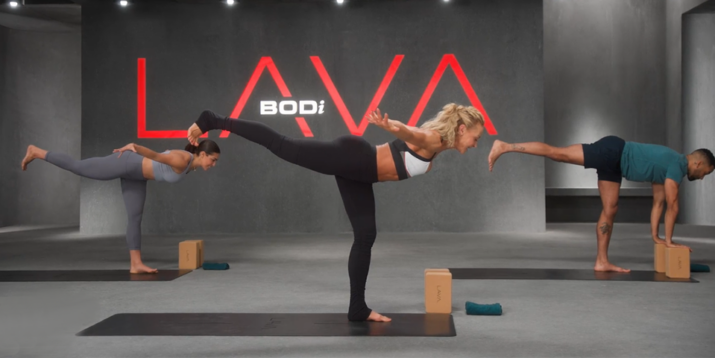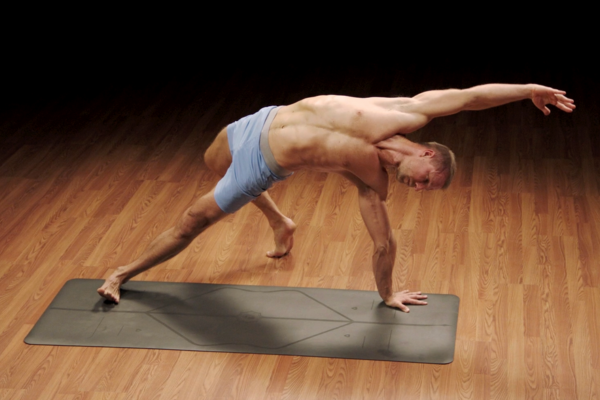What Is Cardio Yoga and Is It an Effective Workout?

Love yoga but also love tough workouts? With cardio yoga, you don’t have to choose.
If you prefer adding pulses to your warrior poses, love doing push-ups in your down dog, or crave the go, go, go flow of sun salutations, this heart-pumping practice may become your new favorite workout.
Think you’re ready to take your practice from a chill stretching session into one that helps meet your cardio goals? Read on to learn the demands and benefits of cardio yoga before deciding if it’s right for you.
What Is Cardio Yoga?
“Cardio yoga is any type of class that incorporates yoga asanas (poses) that get your heart rate up and challenge your cardiovascular system,” says Ann Swanson, MS, C-IAYT, author of Science of Yoga.
The cardiovascular intensity of an activity is determined by how much it challenges your heart and lungs across five zones. Cardio yoga pushes you into the “cardio zone” (i.e., zone 2 cardio and beyond), which is 60 percent or more of your maximum heart rate.
While you might not find classes explicitly labeled “cardio yoga,” forms like vinyasa flow and power yoga fit the bill. These types of yoga move quickly from one pose to the next.
Embodying this more intense approach to yoga is our new program, BODi LAVA. Fusing power yoga and primal movement, it not only trains mobility and flexibility, but also builds strength, burns calories, and works your lungs.
The pace of cardio yoga is faster than what you’d expect from traditional yoga, but a well-designed class also includes rest periods to allow your heart rate to come back down.
“This conditions your heart to become stronger and more resilient,” Swanson says. (Just like a cycling class or run with intervals.)
You may even find yourself doing plyometric movements, like jumping to plank or hopping lunges, between yoga poses that challenge your strength and endurance.
“You’ll probably sweat even if the room isn’t warm,” Swanson says.
What Are the Benefits of Cardio Yoga?

The advantages of a cardio yoga practice like BODi LAVA start with the existing benefits of yoga and build from there:
1. Strength and endurance
The more your muscles work until fatigue, the stronger they get and the longer they’re able to perform. A fast-paced cardio yoga practice will keep your muscles constantly working, leaving less time for recovery between movements.
2. Aerobic capacity
Increased intensity requires more of your heart to pump oxygenated blood to working muscles. The heightened demands of cardio yoga propel your heart rate into graduating zones, forcing your lungs to exert more to oxygenate that faster-moving blood.
3. Efficiency
Yoga that keeps your heart pumping is a time-saver, counting as both a cardiorespiratory workout and a flexibility and mobility practice.
4. Stress reduction
We tend to associate restorative and slow flow yoga with stress reduction, but research shows that you may receive the same benefits from a more strenuous practice.
In one study published in the Journal of Health Psychology, women aged 18 to 30 participated in one-hour sessions of either power yoga or “stretch yoga,” a slow-paced yoga that focused on meditation, breathing exercises, and stretching. According to the research, the women who participated in the stretch yoga session as well as those who took the power yoga class experienced significant reductions in stress.
Can Cardio Yoga Help With Weight Loss?
Weight loss is a complicated equation with multiple variables, including age, sex, genetics, nutrition, lifestyle, and physical activity.
No yoga class is a silver bullet, but cardio yoga, when paired with a healthy diet, may help you burn calories, which can help you achieve a calorie deficit and lose weight over time.
A regular yoga practice may also support your chances of long-term weight loss.
In one recent study, members of the control group enrolled in a behavioral weight loss program that included professional and peer support, a nutritional plan, and guidance on exercise. The intervention group received the same resources, plus two 60-minute Iyengar yoga classes (a slower-paced form of yoga) per week.
According to the report, the yoga group lost significantly more weight (36 pounds vs. 15 pounds) after six months. Yoga also “resulted in greater distress tolerance, mindfulness, and self-compassion and lower negative affect.”
Is Cardio Yoga Better Than “Normal” Yoga?

No form of yoga is “better” than another; they all have their advantages and drawbacks. Your yoga practice should be based on your goals, experience level, health, and preferences.
For example, someone looking for a challenging workout may find that a cardio yoga workout is the best choice for them. But if you’re experiencing high levels of stress, consider a slow flow or restorative class instead.
And if you have any health concerns or injuries, consult with your health-care provider before adding cardio yoga or any new exercise to your routine. Once you receive the go-ahead, you may find it helpful to work with a certified yoga therapist who can answer questions, offer modifications for certain yoga poses, and provide information, resources, and guidance.
Can Beginners Do Cardio Yoga?
If you’re just beginning your yoga journey, start with a class designed for newbies before trying cardio yoga. In addition to learning the names of many poses and how to get into them safely, a slower-paced class will also give you an opportunity to learn how to breathe properly, which is the key to any yoga practice.
“A fast-paced yoga class may be harder for a beginner who doesn’t know the movements or safety cues yet,” Swanson says.
If you attempt a class that feels like cardio yoga and feel a bit in over your head, listen to your body, adjust the pace as needed, and do what can.
“Don’t get discouraged,” Swanson says. “Feel free to take breaks and visualize movements.” The same advice applies to yogis of all levels of experience.
Once you have the basics down, you may be ready for BODi LAVA, which offers cues and modifications to meet you where you are.
